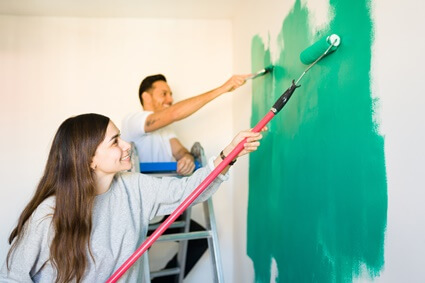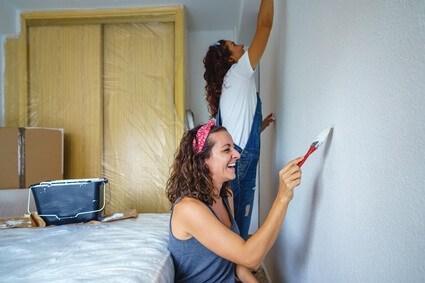Last Updated on October 1, 2023 by Louise Carter
Redecorating a bedroom reduces the number of places to sleep. Unfortunately, sleeping in a newly painted room is inadvisable for health reasons, especially if you fall into a high-risk group.
Oil-based paints are usually wet and slick for up to 24 hours, while water-based paints are usually touch-dry within 2 hours. However, that doesn’t mean you can sleep in the room safely.
Ventilate the room before you sleep there because paint releases volatile organic compounds (VOCs).
Wait at least 72 hours before spending any prolonged time in an emulsion-painted room, especially sleeping. If you’ve used oil-based paint, allow up to 2 weeks.
Can You Sleep in a Bedroom After Painting?
Choosing the perfect paint color for a bedroom can go a long way to improving the quantity and quality of sleep. However, you must wait before enjoying the fruits of your decorative labors.
The answer to “Can you sleep in a newly painted room?” depends on various factors.
You’ll need to consider other factors, like what kind of paint was used to decorate, the time of year you get the work done, and what timeframe constitutes ‘newly painted.’
Why Should I Not Sleep in a Newly Painted Bedroom?
There are two main concerns related to sleeping in a newly decorated room: the inhalation of paint fumes and the damage that can be done to paint that isn’t fully dry.
Wet Paint
Wet paint and wallpaper emit fumes, and you risk damaging your clothing by walking into it. You’ll also risk marking the walls and creating permanent imperfections by smudging the paint.
How long the paint takes to dry depends on the materials used and the time of year. Latex or acrylic, water-based paints are preferable due to their quick drying time.

Paint Fumes
Sleeping in a room with airborne paint fumes should be avoided. The most common side effects of spending time in a room with paint fumes include the following:
- Headaches.
- Dizzy spells.
- Nausea.
- Irritability in the throat and shortness of breath.
- Temporary blindness.
- Short-term memory loss.
Paint fumes stem from liquid ingredients evaporating into the air when paint reaches room temperature.
The reaction to liquid ingredients, like solvents evaporating, releases volatile organic compounds (VOCs).
If you’ve got a pet bird in your bedroom, move it before you start painting. Birds’ respiratory systems are particularly susceptible to airborne toxins.
Hazards of VOCs
The following VOCs can be found in tinned paint used to decorate homes:
- Acetone.
- Benzene.
- Dichloromethane.
- Ethanol.
- Formaldehyde.
- Glycol ethers.
- Propylene glycol.
- Styrene.
- Toluene.
- Trichloroethylene.
- Xylene.
To avoid flooding your bedroom with VOCs, shop carefully when choosing your paint.
Sleeping in a room with oil-based paint must be avoided because they’re high in VOCs. Latex or acrylic paints are water-based and contain fewer toxins.
When you review paint tins, some are marketed as low-VOC or zero-VOC. This is undeniably advantageous, but the paint can still have a strong smell with side effects.
According to The Annals of Occupational Hygiene, water-based paints can still irritate the throat.
High-Risk Groups
Everybody must avoid VOCs. Even many professional decorators wear face masks to protect themselves from airborne toxins. However, some people are at more risk than others.
The first high-risk group is anybody with a pre-existing respiratory condition. VOCs can trigger severe asthma or chronic obstructive pulmonary disease attacks.
If you’re pregnant, approach paint cautiously. According to Environmental Health, unborn infants in the first trimester can suffer congenital disabilities due to inhaling VOCs.
Babies and young children remain vulnerable after birth, so be mindful about how you paint a nursery or a child’s bedroom. Cancer Causes Control links VOCs to leukemia in very young children, while exposure can also increase the risk of developing asthma.
Certain pets are highly sensitive to VOCs as their lungs can’t filter the toxins. Paint fumes can instantly kill pet birds, but cats and dogs are also at risk.
How Long Before You Can Sleep in a Freshly Painted Room?
If you’ve recently painted a bedroom using water-based latex or acrylic paint, don’t sleep there for 72 hours. If you’ve used oil-based paints, wait up to 2 weeks before sleeping in the room.
This may sound draconian, but it takes time for the paint to dry and the room to ventilate.

Testing Dryness of Paint
If light levels are good, likely in the early afternoon, you can see if the walls are still drying. A partially wet wall will have visible patches of wet and dry paint.
If light levels are insufficient, touch the wall and see if your finger is stained. This may be messy and risks leaving an imperfection in the painted finish, but it’s effective.
However, the difference between dry and cured paint must also be noted.
When the paint is touch-dry, the solvents have fully evaporated. In theory, this also means your room is VCO-free. However, the paint still needs longer to cure.
Cured paint has reached 100% hardness, which you need before sleeping in a room. While oil paints take longer to touch dry, they can cure within 72 hours.
It can take latex or acrylic paints up to a month to cure. You can’t be expected to spend a month outside your bedroom, especially if space is limited.
Just be aware of the hazards of uncured paint when you return to the room. Avoid hanging anything on the wall or moving heavy furniture lest you scratch your newly painted walls.
Ventilation
Knowing how long to ventilate after painting a bedroom is fundamental to safety. Good ventilation is essential because opening a small window for an hour won’t clear the room of paint fumes.
To ventilate a room after painting walls, follow these simple steps:
- Open all windows as wide as possible.
- If it’s safe to do so, open the doors. Skip this step if you live with children or pets.
- Use an air purifier to dissipate lingering VOCs.
- Use fans to redistribute air around the room and expedite the drying process.
Maintain this up for 3 days without sleeping in the room. Even then, don’t take any chances. Sleep elsewhere if you can still smell paint when you enter the bedroom.
Waiting for a freshly painted bedroom (with a newly fitted carpet or professionally cleaned carpet) to be available is frustrating, especially if you’re excited about the redecoration.
Always give the room sufficient time to ventilate and dry, even if it causes short-term inconvenience.







